In this post, you will learn about the fascinating ecology of zebra longwing butterflies as well as which native nectar and host plants will entice them to your garden.
* All photos on this page were taken by me unless otherwise noted. Please provide content and photo credits to thesouthernwildgarden.com.
Why zebra longwings?
Zebra longwings are incredibly attractive bugs that will charm you with their graceful flight and striking wing pattern. As their name suggests, these butterflies have slender elongated black wings patterned with pale yellow stripes that are reminiscent of similarly striped animals found on the plains of Africa. The zebra longwing’s exotic looks will bring a wild tropical vibe to your day.
In addition to the obvious aesthetic appeal zebra longwings bring to any garden, they are also important pollinators for native plants. Zebra longwings are unusual for a butterfly in that they eat pollen as well as drink nectar. Because of this behavior, they frequently have pollen stuck to their proboscis which they carry from flower to flower as they forage.
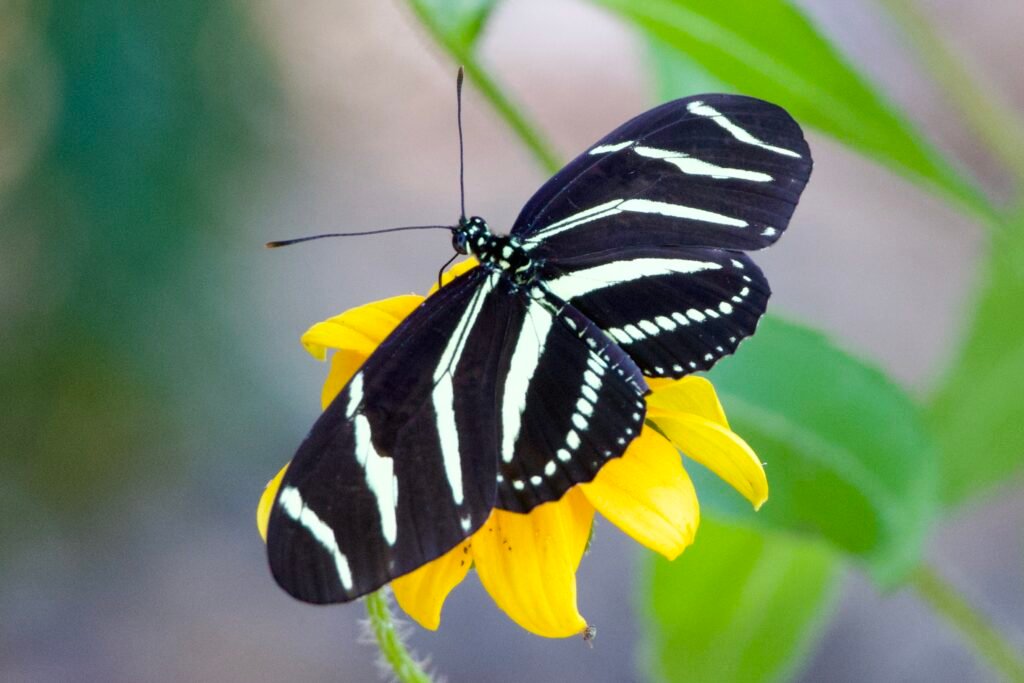
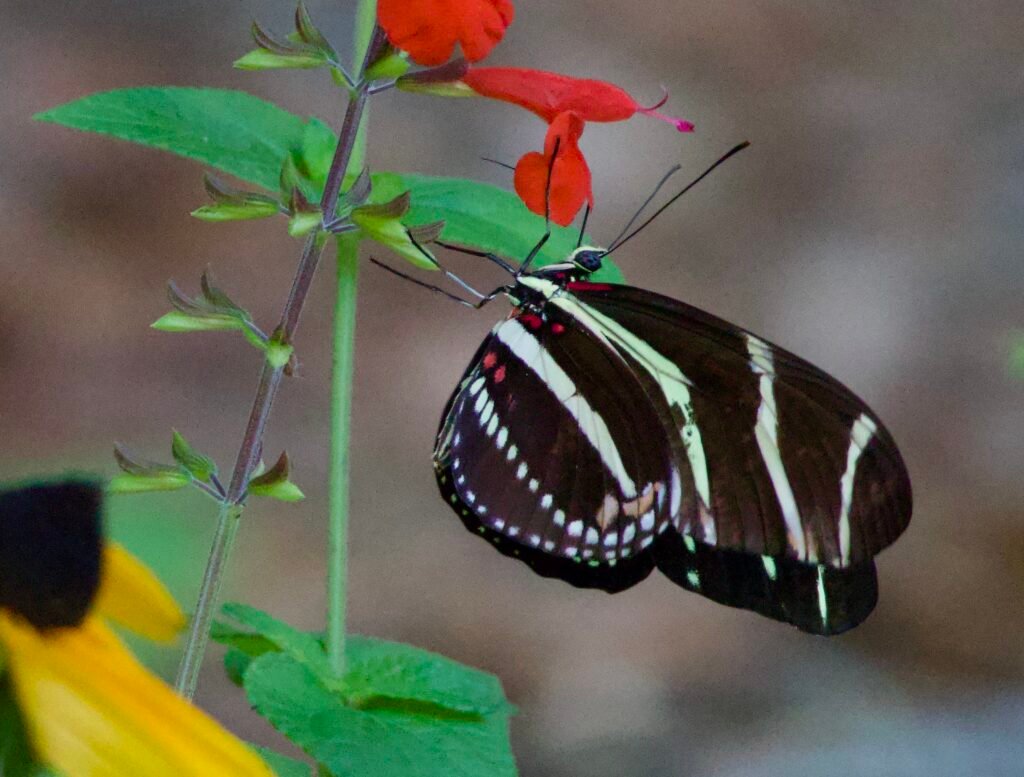
What is a zebra longwing?
Zebra longwings are butterflies in the brush-foot Family Nymphalidae which is the largest and most diverse family of butterflies. All brush-foots look like they only have four legs because the first set of legs is very small and brush-like, hence the name. Within this family, zebra longwings, along with fritillaries and Julia, belong to the Subfamily Heliconiiae or longwing butterflies. Longwing butterflies are characterized by slow fluttery flight and holding their wings open when feeding on flowers or basking. Most of these butterflies also use passion vines as host plants, but more about that later.
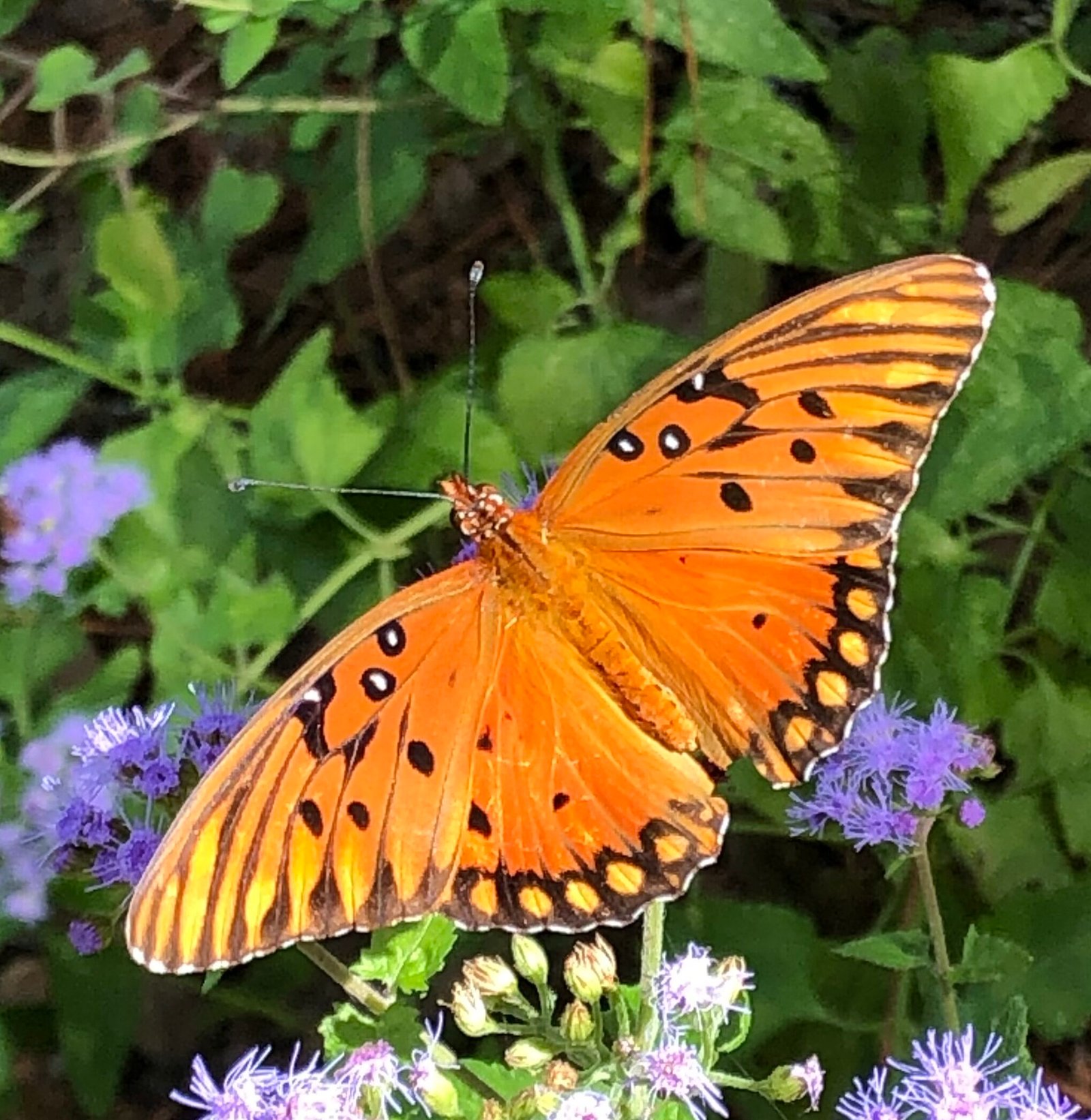
Heliconius Butterflies
Within Heliconiiae, zebra longwings are in the Genus Heliconius, a group of colorful tropical butterflies whose ecology is really fascinating. Researchers have studied Heliconius butterflies extensively for over 150 year primarily in the Amazon Basin where they find the majority of the species in this genus fluttering about the jungle.
Most of the research on Heliconius butterflies revolves around the different species’ tendency to evolve wing patterns and coloration very similar to each other regionally, a phenomenon known as mimicry. In this case, it’s specifically Mullerian mimicry because the various Heliconius butterflies all posses a taste that is unpalatable to most predators as a result of feeding on the toxic leaves of passion vine as caterpillars and have developed physical similarities to take advantage of a predator avoiding all butterflies that look alike after having a bad experience with one. The diversity of different color patterns found within one species of Heliconius butterfly and the similarity of those patterns among species where they overlap is astonishing. If you’d like to learn more, start here.

The name Heliconius refers to Mount Helicon in Greece. In mythology, the ancient Greeks considered this mountain the source of poetry and music, and many of the charming Heliconius butterflies have species names derived from various goddesses associated with the arts. Zebra longwing’s species name charithonia comes from the Charites who were believed to inspire joy and personify beauty.
Key Attributes
| Scientific Name | Heliconius charithonia |
| Identification | Long, narrow, black wings with pale yellow stripes |
| Distribution | Northern South America, Central America, West Indies, Southern North America |
| Size | Wing span 2.75 – 4 inches |
| Habitat | Tropical hammocks, moist woodlands, forest edges and nearby open areas |
| Flight | Year-round in South Florida and Texas, moves north in warmer months |
| Host plant | Passion vines including Passiflora lutea and P. Suberosa |
| Nectar plants | Firebush (Hamelia patens), Scarlet sage (Salvia splendens) |
Unlike other Heliconius, zebra longwings do not vary much in color or pattern across their range from northern South America to the southern United States. They are the only Heliconius butterfly regularly found within North America and are generally restricted to Florida and Texas year round. However, in the warmer months, you may find them as far north as Nebraska and South Carolina. In some years, I have had zebra longwings in my garden in coastal Georgia through November.
How to attract zebra longwings?
First, check your location. If you live within the zebra longwing’s range, you’ll want to have their native host plant, passion vine, as well as their preferred nectar plants in your garden to lure them in. In addition, as a dark butterfly that warms up easily, zebra longwings will often seek shade during hot weather, so providing flowers and passion vine in a mixture of sun and shade will allow them to spend more time in your yard.
Host Plants
Passion Flowers
Zebra longwings lay their eggs exclusively on their host plants in the Genus Passiflora, commonly known as passion vine or passion flower. Most of the species in this family are found in the tropics of Central and South America, but over a dozen native species of passion vine occur in North America primarily in the southern states of Florida, Texas, and Arizona. A few commonly available to gardeners within the Southeast are purple passion flower also known as maypop (Passiflora incarnata), corkystem passion flower (Passiflora suberosa), and yellow passion flower (Passiflora lutea).
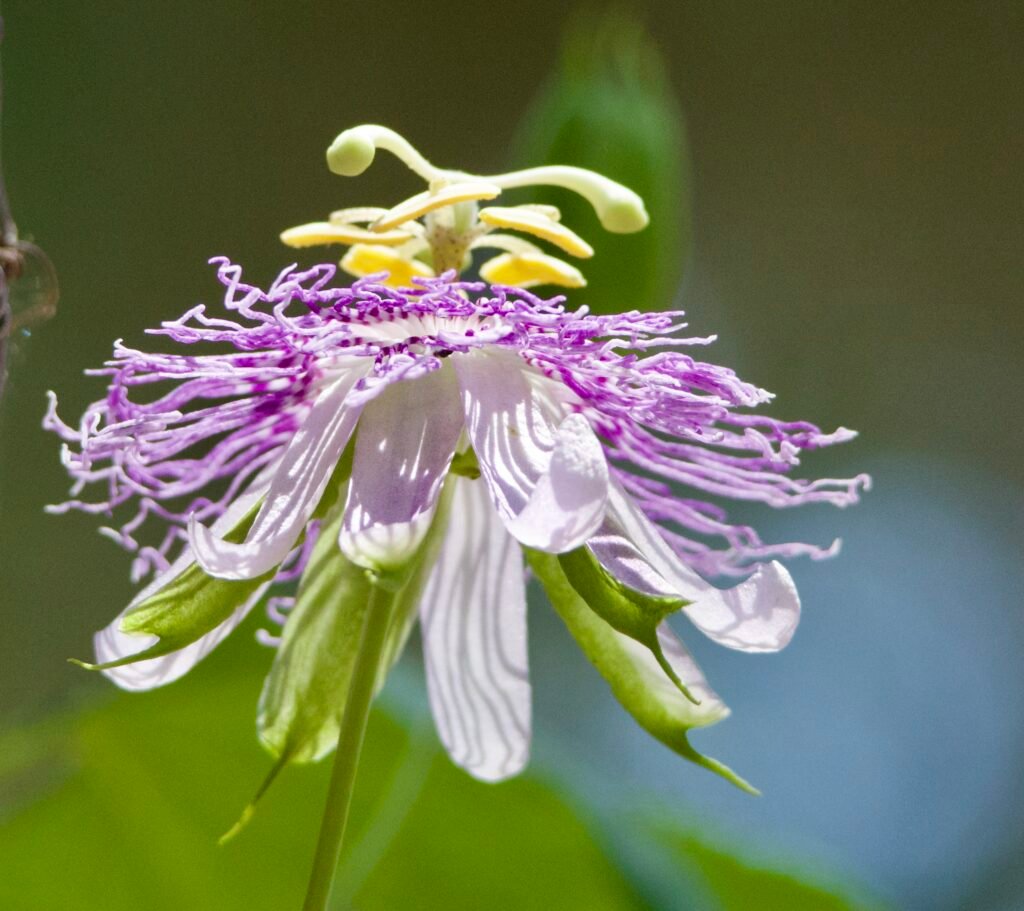
How to Grow Passion Flower
Purple and yellow passion flowers have the widest distribution of the North American Passiflora, growing in the central and eastern US as far north as Pennsylvania. Purple passion flower is fairly flexible in it’s preferred habitat conditions and will readily grow in full sun to part shade in a variety of soil types, while yellow passion flower generally likes more shade and fertile, average to moist, well drained soils. Both species are considered easy to grow in a garden setting.
Also referred to as passion vine, these plants are a flowering vine that will happily grow up to 25 feet in length, rambling along the ground or using it’s tendrils to climbing any available structure. Purple passion flower is known to become unruly, using underground runners to send up shoots and spread as far as it is allowed, while yellow passion vine is considered better behaved in the garden.
Both plants produce unique pretty flowers with wavy petals and showy stamens followed by edible fruits that wildlife finds tasty but humans not so much. I would highly recommend growing the native straight species of passion vine rather than a cultivar as some butterfly species will not use genetically modified plants as host plants.

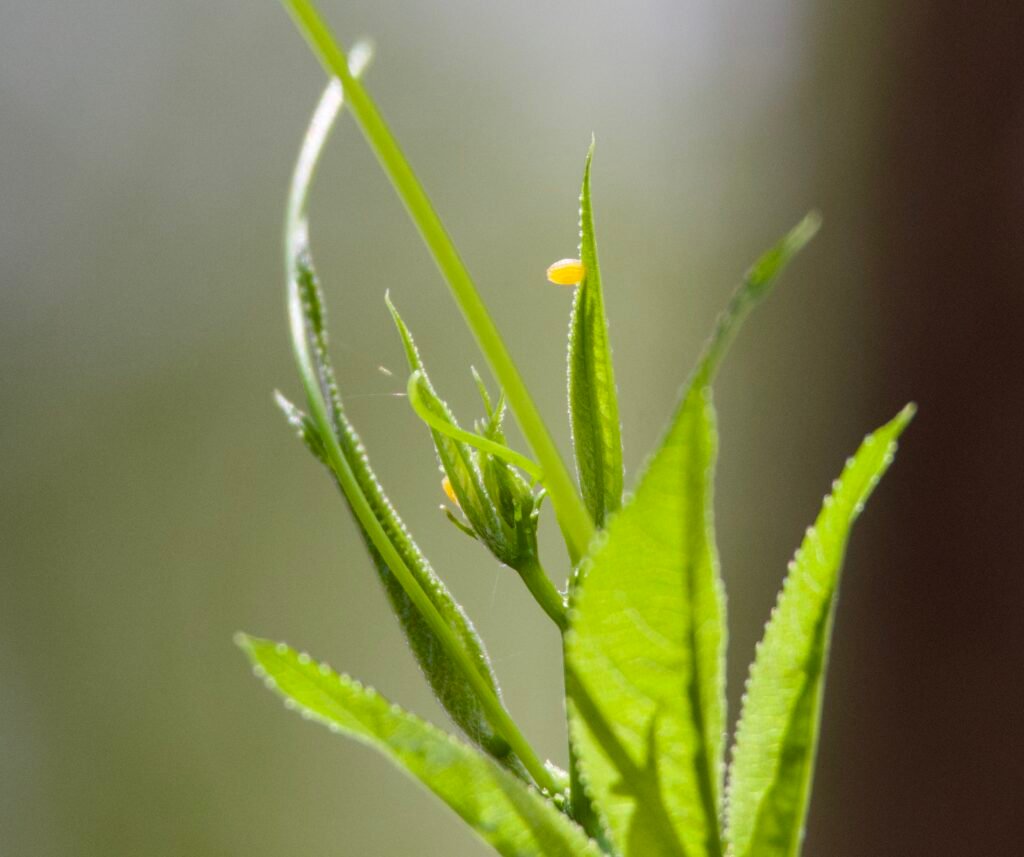
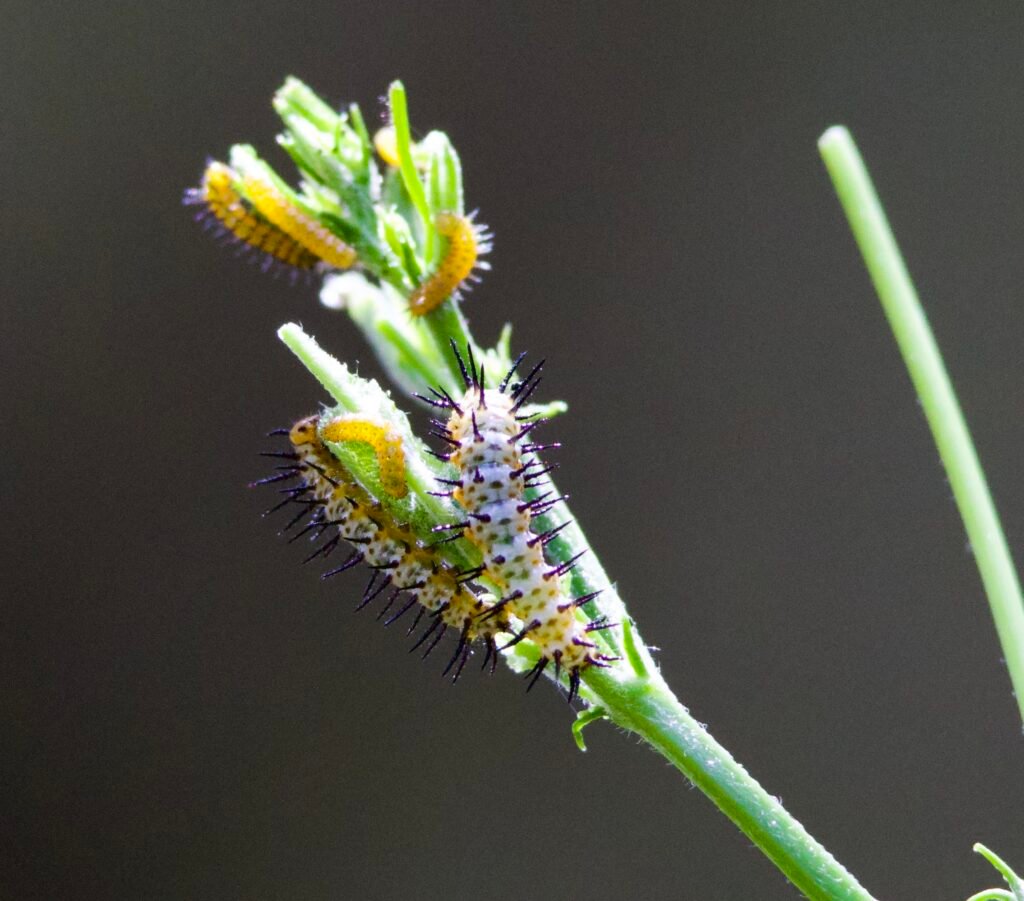
Egg Laying and Larval Stage
Zebra longwings will often lay their small yellow eggs in clusters on the tips of new leaf growth and tendrils of passion vines. Eggs will hatch tiny yellowish caterpillars that will molt and grow into white caterpillars with black spots and spines. Spines are harmless, but the distinct coloration is a warning to predators that they, like the adults, are toxic to predators.
Passion vine is an attractive host plant because the leaves contain chemical compounds which make caterpillars and adult butterflies unpalatable to predators like birds. The coevolution of Heliconiinae butterflies and passion vines is another interesting story which I won’t get into, but feel free to explore the topic here or here. Because passion vine is a host to numerous butterfly species including fritillaries, you will frequently find caterpillars of multiple species munching down on your passion vine throughout the growing season. In most cases, gardeners will find their passion vine completely denuded of leaves multiple times throughout the summer. At higher latitudes, passion vine naturally dies back in the winter, although yellow passion flower is a little more cold hearty than others.
Chrysalises and Pupal Mating
Caterpillars will form chrysalises on their host plant or on plants nearby. Chrysalises are the shape and color of a dead leaf, allowing caterpillars to remain camouflaged while they transform into butterflies. Male and female zebra longwings will emit different chemicals as they complete metamorphosis allowing male adult butterflies to detect whether the butterfly that will emerge from a chrysalis will be a female. Adult males will guard a chrysalis with a developing female until she is mature enough for mating. Referred to as pupal mating, this behavior is common across the Heliconius butterflies and is thought to benefit females by allowing them to lay eggs earlier as well as mate with the fittest males strong enough to defend her chrysalis from rivals.
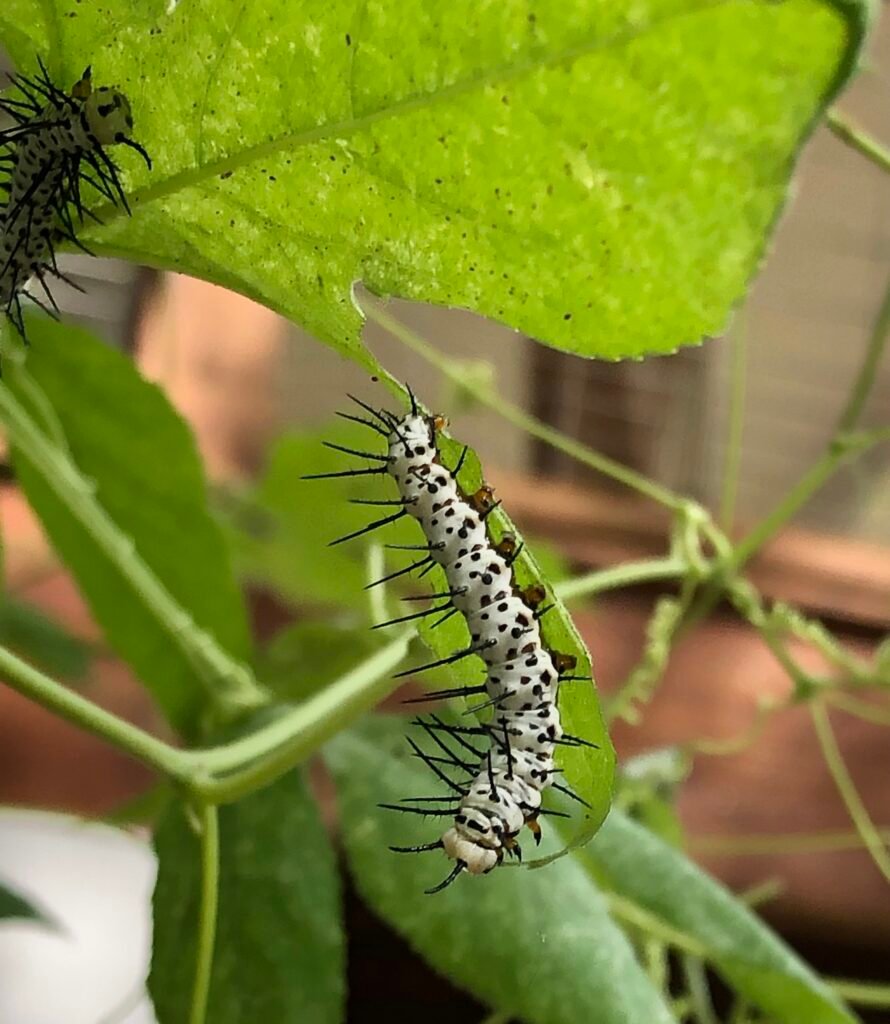
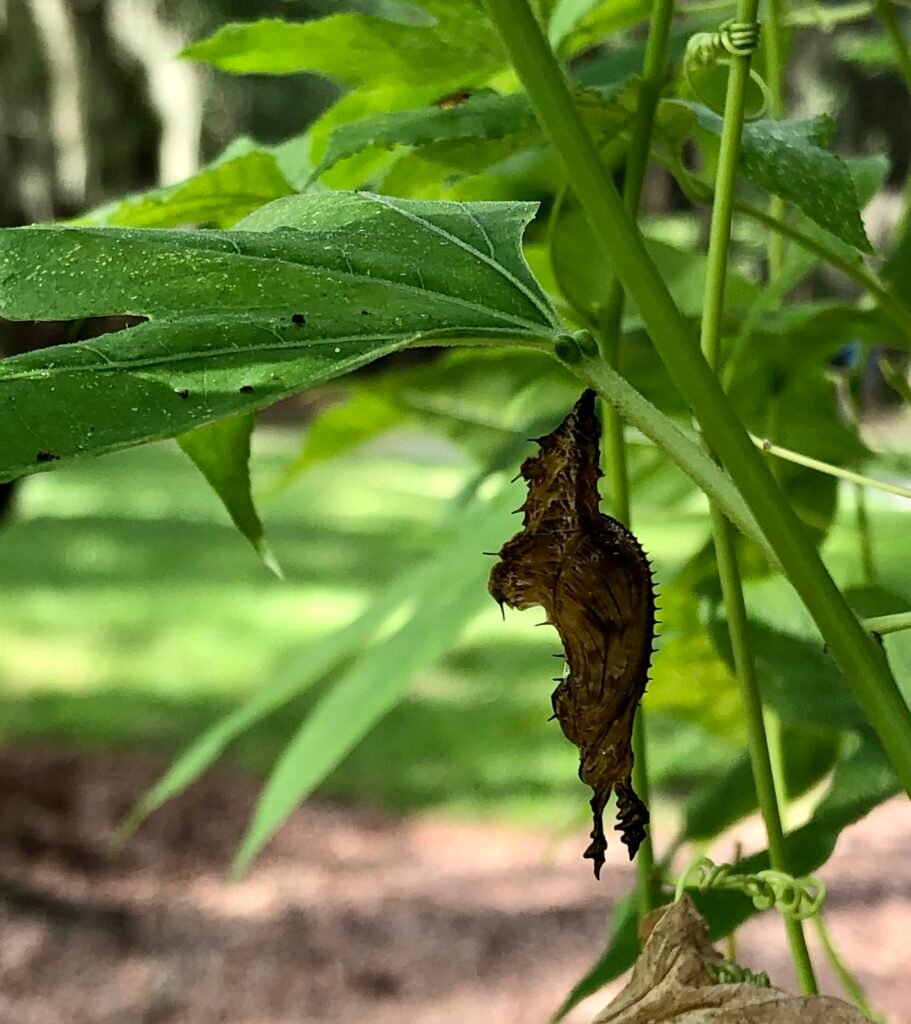
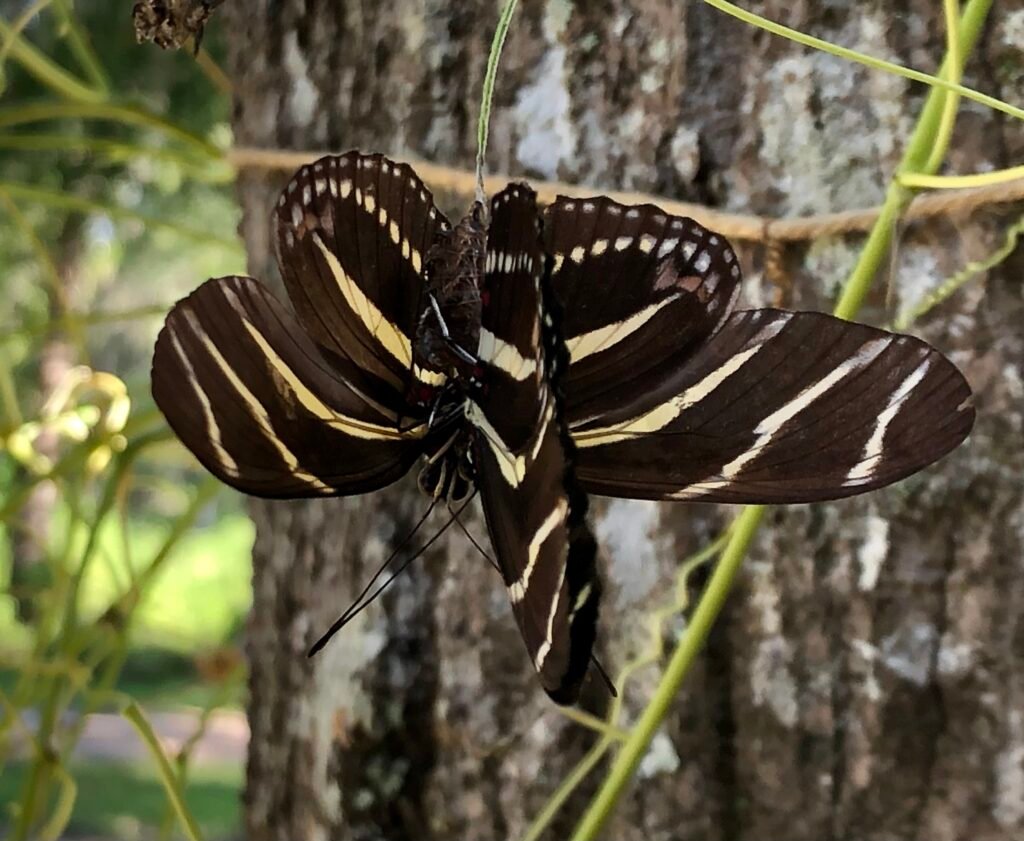
Nectar Plants
Pollen Eating
Because zebra longwings eat pollen as well as drink nectar, they have a long lifespan for a butterfly, living a few months instead of only a couple of weeks like most butterflies. This nutrient rich food source combined with a long lifespan allows zebra longwings to lay eggs multiple times throughout their lives. Most butterflies lay eggs only once shortly after emerging as adults, and they tend to rely on nutrients gained in their larval form to produce eggs. Pollen is so important to zebra longwings that they will remain in an area with their preferred flowers even if caterpillars have completely defoliated the passion vine nearby. Researchers have shown that zebra longwings, as well as other Heliconius butterflies, have enhanced memory and learning capabilities allowing them to establish ‘traplines’ to regularly return to favorite forage plants.
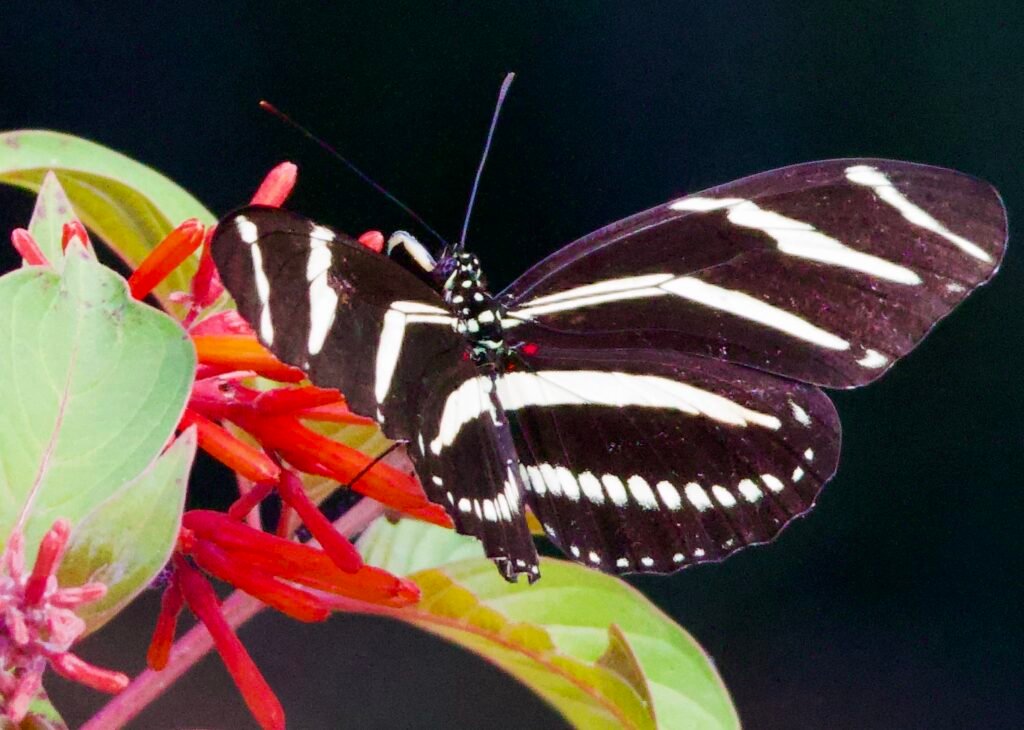
The Heliconius butterflies in the tropics appear to have coevolved as pollinators for various species of vines in the gourd family (Cucurbitaceae), especially those known as jungle cucumbers. Heliconius’ unique ability to eat pollen makes it an attractive pollinator for plants, and these wild cucumbers of the tropics evolved to take advantage of this trait. Most of these jungle vines have flowers that are pink, red, or orange and tubular in design, and folks have observed zebra longwing’s preference for small red and orange tubular flowers across their range in North America.
Native Favorites: Scarlet Sage and Firebush
So now knowing how important the right forage plants are for zebra longwings, what should you grow in your garden? Zebra longwings love to feed on native plants such as scarlet sage (Salvia coccinea) and firebush (Hamelia patens). Scarlet sage is native to the southeast and will grow well in well drained soils in full to part sun. Its small red tubular flowers are very attractive to zebra longwings as well as hummingbirds, bees, and other butterflies including spicebush and Palamedes swallowtails. It flowers throughout most of the growing season especially if cut back periodically, providing a welcome nectar source in early spring as well as late fall. Scarlet sage is a perennial in warmer climates, but also readily reseeds.
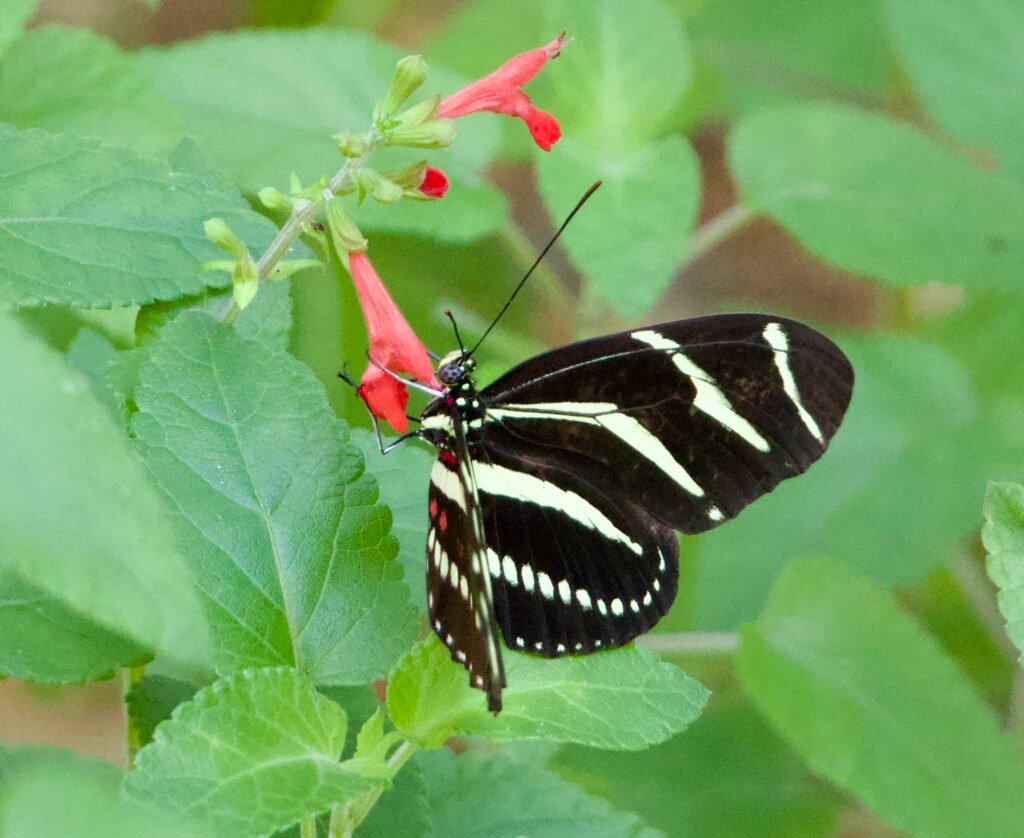

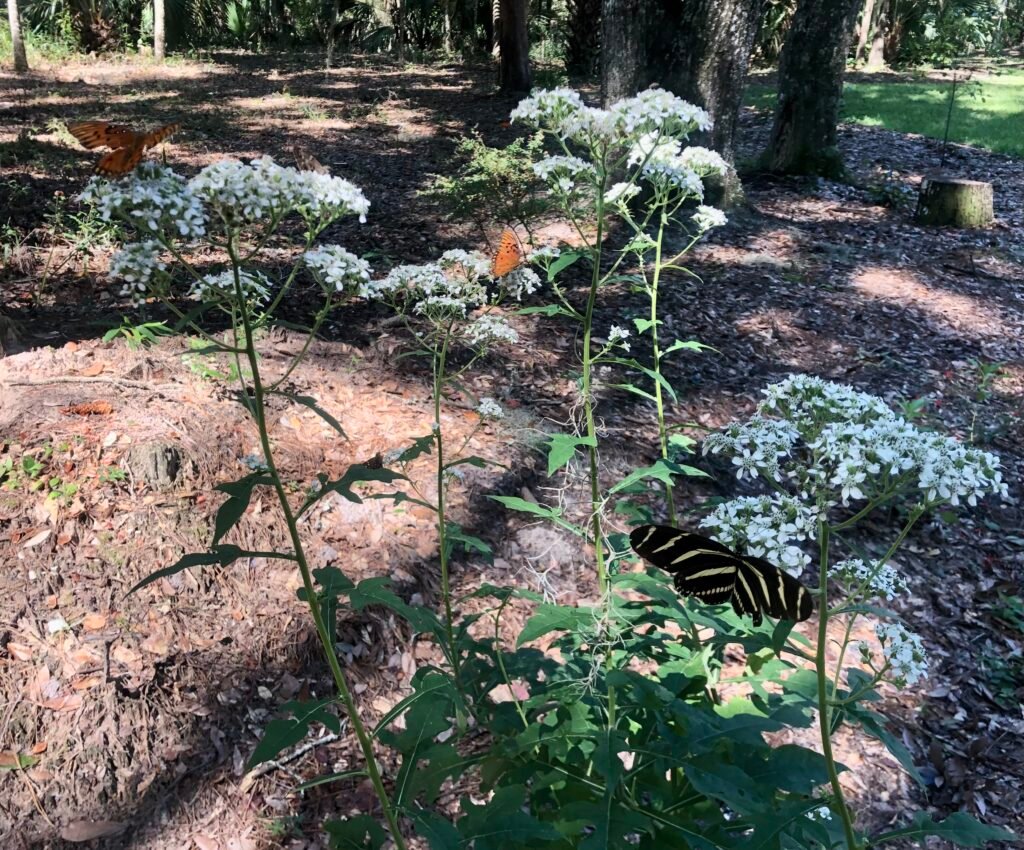
Non-native Tropicals
In addition, zebra longwings find some tropicals not native to the southeastern US like zinnias (Zinnia spp.), lantana (Lantana spp.), and firespike (Odontonema strictum) very attractive. There are species of lantana native to south Florida and Texas, but the lantana you commonly find at nurseries will most likely be cultivars or species from Central and South America. Gardeners should do their due diligence if planting lantana to ensure they are not growing the invasive plant pest large leaf lantana, Lantana camara. Peruvian zinnia (Zinnia peruviana) is native to the southwest and has naturalized in some parts of the southeast including Florida, Georgia, South Carolina, and North Carolina.
Native Asters
Some other native plants in the Aster Family (Asteraceae) including frostweed (Verbesina virginica), cutleaf coneflower (Rudbeckia laciniata), Spanish needle (Bidens alba), purple coneflower (Echinacea purpurea) and Elliot’s aster (Symphyotrichum) are very good at attracting zebra longwings. Spanish needle and Elliot’s aster are aggressive spreaders and may not be suitable for your garden. However, if you have the space, Elliot’s aster, in particular, is a beautiful plant with abundant lavender flowers in the late fall that seem irresistible to zebra longwings as well as bees and skippers. Elliot’s aster prefers moist to wet soils in full sun and is native to the southeastern Atlantic coastal plain.
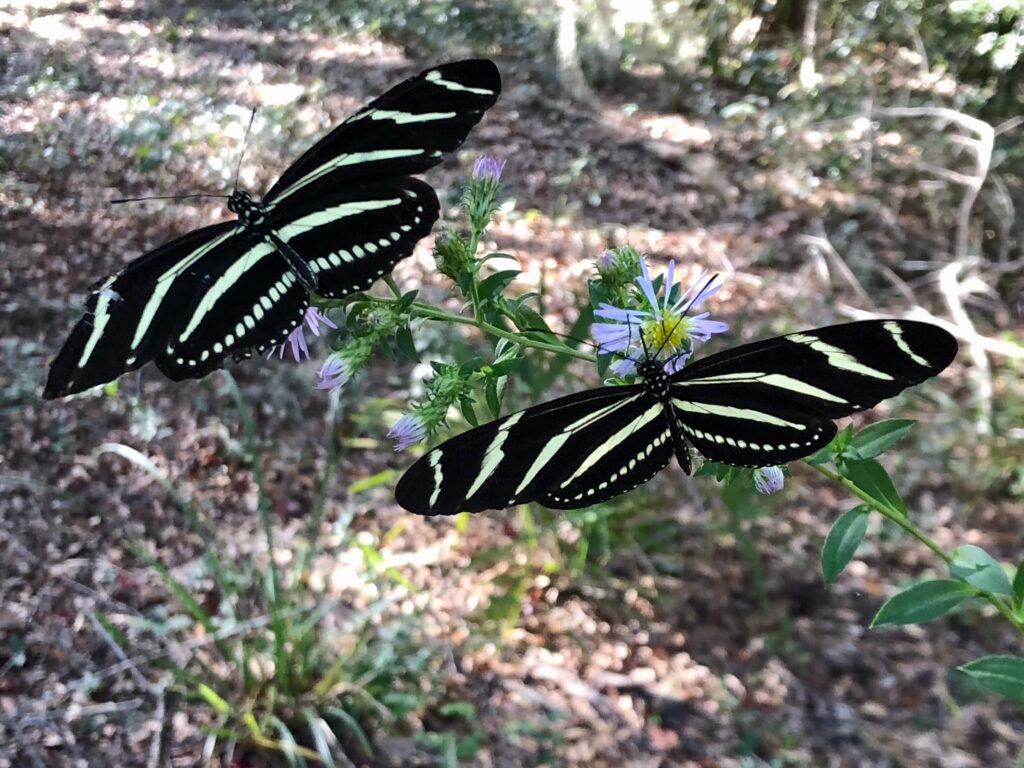
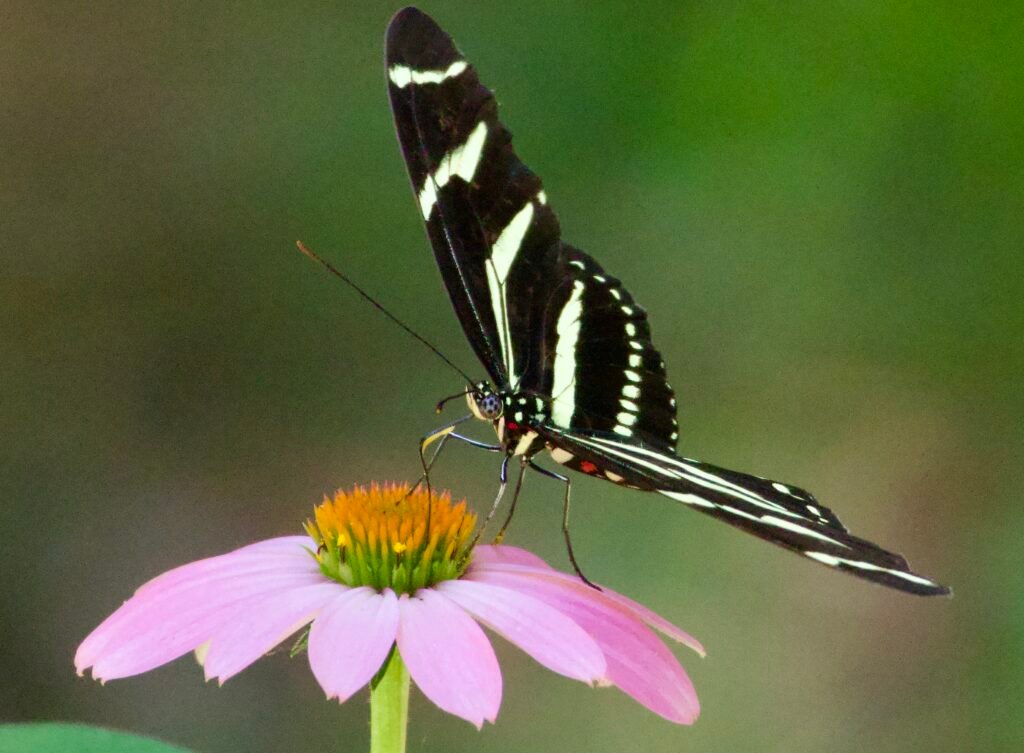
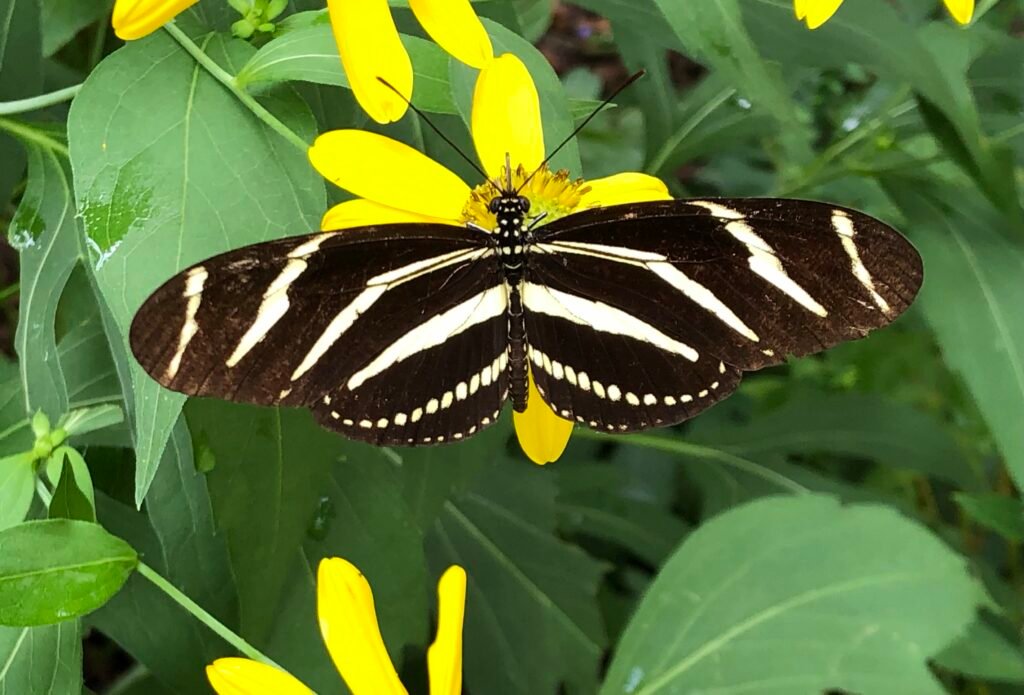
What else is cool about zebra longwings?
Communal Roosting
Zebra longwings and other Heliconius form communal roosts. Communal roosts are places where a number of butterflies will gather close to each other to spend the night. These roosts may have just a few or up to 60 individuals. These roosts appear to provide protection to the adults by deterring predators. Folks frequently observe zebra longwing roosts on clumps of Spanish moss (Tillandsia usneoides) in addition to fine twigs or tendrils of vines. Roosts are generally less than 2 meters from the ground and in deep shade. Some roosts are very stable. Individual zebra longwings will use the same roost night after night and then will disperse each day to their own foraging area.
Where can I learn more about zebra longwings?
- Bound by Beauty: Create your own nature channel with a flock of roosting zebras in your garden
- Florida Entomologist 2005: Dynamics of a subtropical population of the zebra longwing butterfly Heliconius charithonia by Fleming, Serrano and Nassau
- heliconius.org: Home of the passion vine butterflies
- Tree of Life: Heliconius pages
- Current Biology 2023: Long-term spatial memory across large spatial scales in Heliconius butterflies by Moura, Young, Monllor, Cardona, and Montgomer
- Proceedings of the Royal Society B: Biological Sciences 2012: The benefit of being a social butterfly: communal roosting deters predation by Finkbeiner, Briscoe, and Reed
- Happy Butterfly: Florida’s zebra longwing is easy to attract
- Proceedings of the Royal Society B: Biological Sciences 2009: Sex-specific chemical cues from immature facilitate the evolution of mate guarding in Heliconius butterflies by Estrada, Yildizhan, Shultz, and Gilbert
- Harvard University: Mallet Group
- Butterflies and Moths of North America: Zebra Heliconian
- National Geographic Research 1986: Gregarious roosting and home range in Heliconius butterflies by Mallet
- Biological Review Cambridge Philosophical Society 2018: The arms race between Heliconiinae butterflies and Passiflora plants – new insights on and ancient subject by Castro, Zogrobelny, Cardoso, and Bak
- The Ecology and Evolution of Heliconius Butterflies 2017 by Jiggins
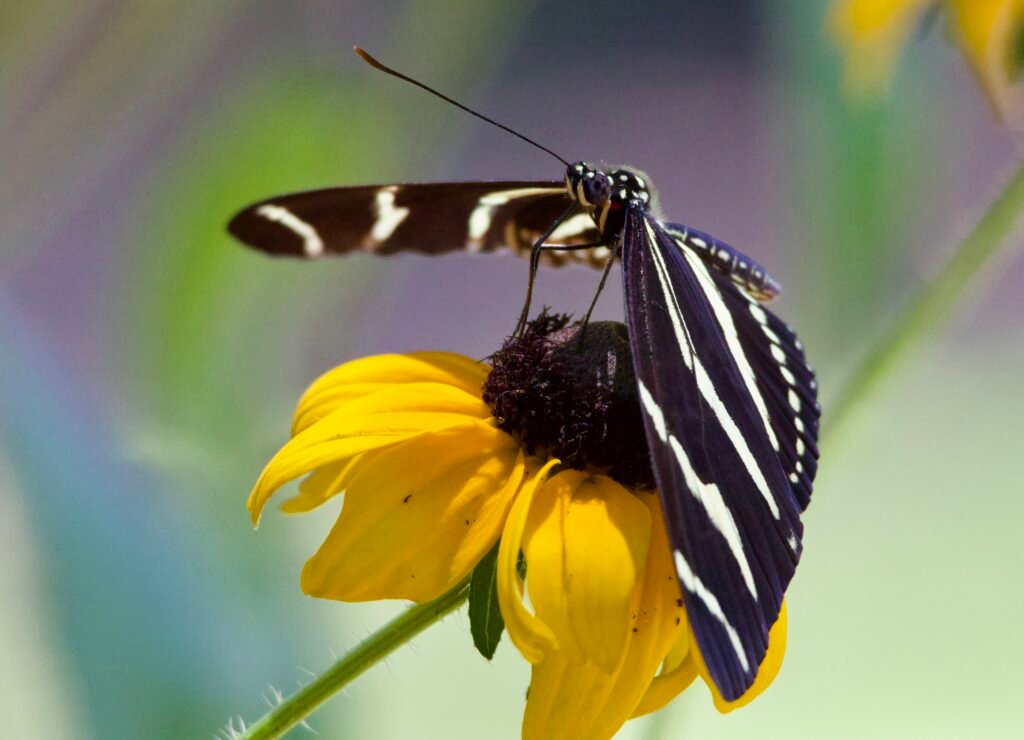
What a great read! The information is awesome. Love the photos. Thank you for taking the time to provide links to additional information.
Wow, I love Zebra long wings but have noticed a decline in population in NE FL in the past few years. Your article was informative and may help me (and especially my wife) to introduce more host plants in our garden. Thank your for the education.
Pingback: The Southern Wild - Spotting Silver: How to Attract Gulf Fritillary Butterflies
Pingback: How to Grow Scarlet Sage
Pingback: The Southern Wild - Grow Frostweed in Your Native Plant Garden